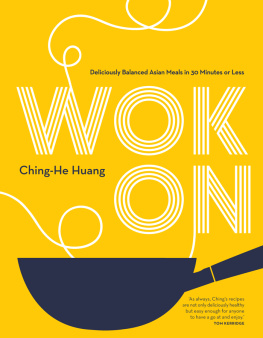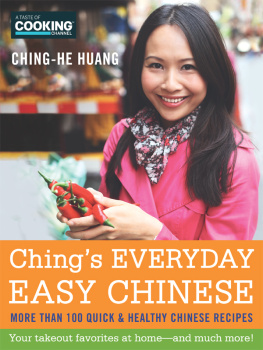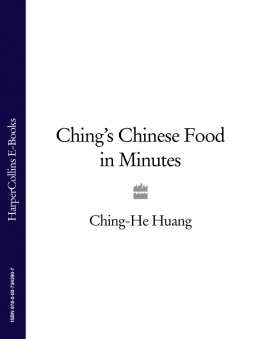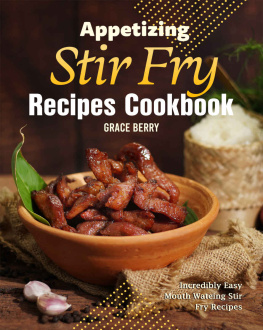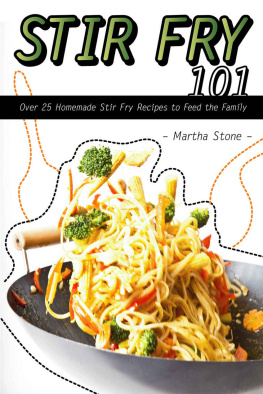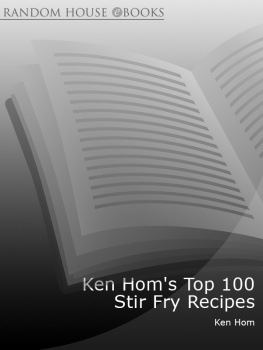For my mum, my No.1 fan.
Ching-He Huang is an Emmy-nominated TV chef and cookery author. Born in Taipei, Taiwan, her culinary ethos is to use fresh, organic, ethically sourced ingredients to create modern dishes that fuse Chinese tradition with innovation and are accessible for home cooks. Her immensely popular TV series include Chinese Food Made Easy, Chinese Food in Minutes, Exploring China and Chings Amazing Asia. She has also been a regular guest chef on Saturday Kitchen and Lorraine.
Ching has written seven bestselling cookbooks: Eat Clean: Wok Yourself to Health, Exploring China, Chings Fast Food, Everyday Easy Chinese, Chings Chinese Food in Minutes, Chinese Food Made Easy and China Modern. She is also the creator of The Lotus Wok a wok with a dynamic nano-silica coating for high performance cooking. Ching divides her time between the UK, the US and Asia.

Contents
How to use this Ebook
Select one of the chapters from the and you will be taken to a list of all the recipes covered in that chapter.
Alternatively, jump to the to browse recipes by ingredient.
Look out for linked text (which is in blue) throughout the ebook that you can select to help you navigate between related recipes.

Hello!
Thanks so much for choosing Stir Crazy. I hope it will inspire you to pick up the wok and have some fun when it comes to those all-important mealtimes!
Stir Crazy is a collection of delicious stir-fry recipes that I designed with busy people like you in mind. They are for all occasions and simple enough for everyday healthy cooking at home, with nutrition, taste, affordability and balance in mind.
Ive written a handful of books on Chinese cookery and being a Chinese cookery expert I always get asked the same questions: How do I make a really good stir-fry so the veggies are crisp and fresh and dont go all soggy? I make stir-fries at home all the time but its so boring, what flavours can I try? What sauces can I make? What tips and tricks can you offer?
If these are the questions plaguing your everyday kitchen/stir-fry needs, then this is the book for you. I demystify the art of making a good stir-fry and offer you tips on getting it right. Whether its a saucy dish or a crispy dry-fry, whether you are a vegetable or meat lover, a novice or an experienced cook, here is a varied and wide range of dishes that I hope will help you increase your stir-fry repertoire.
So lets get startedand happy wokking!
Love,


Mastering the wok
Why stir-fry?
Stir-frying is quick and its easy to start, but it is not always so easy to master. Learning what separates a good stir-fry from a great one takes time and the willingness to do a wok dance (see )! It is all about the timing knowing when to add what and how to get the best out of each ingredient.
Stir-frying can also be inexpensive and by cooking on a concentrated heat with a small amount of oil you retain more of the nutrients, yet the heat helps to break down the fibres, making it easier for you to digest the food and absorb the nutrients.
This way of cooking is fun, fast and can be healthy too, depending on what type of dish you are making and what you are putting into it.
Why use a wok?
This 2,000-year-old magical cooking pot is a way of life all over Asia and is used for sauting, braising, frying and steaming. It can be a challenge cooking for family mealtimes and an express tool such as this clever vessel can be a lifesaver on busy days. It is the ultimate stir-fry implement!
How do I go about choosing a wok?
If you are really into healthy eating, I would suggest a stainless steel wok. It can be seasoned with coatings of apple cider vinegar, each coating evaporated to give a clear, thin non-stick layer. However, stainless steel as a material sometimes has uneven heat spots and food can stick, plus it doesnt retain heat as well as carbon steel.
Most professional Chinese chefs use unseasoned carbon steel woks but they need a lot of love and care or they rust. Non-stick varieties, however, are not ideal since the coating comes off with time. Some carbon steel woks have a flat, wide base more like a saucepan, which is not a traditional wok shape, so look for ones with deep sides (to allow you to toss the food) and a small centre (to concentrate the heat). Traditional woks are round-bottomed but these require a wok ring set over your stove, which is another added piece of equipment and not ideal for the modern home, especially induction hobs, which many homes have now.
Aluminium woks are inexpensive but they can rust and warp and are not as good conductors or retainers of heat as carbon steel woks.
My grandmother used to cook on a cast-iron wok and they are the best, but they are extremely heavy and it can be difficult to toss the food or manoeuvre them away from the hob when the heat gets too hot.
Whatever wok you have, however, I always say its best to use it and not waste it. When its on its last legs and you need a replacement, please do seek out my Lotus wok. I designed it for people who want a better wok experience. It is inexpensive and is made from carbon steel so that it heats quickly, plus it has a natural, nonstick type, nano-silica coating (made from sandblasted crystals). It is a medium gauge, so not too heavy yet not flimsy. Its also scratch resistant, so you can use metal utensils on it, and hydrophobic, which means it repels water, giving your veggies that crisp finish, and oleophilic, which means it allows just enough oil to coat the surface of the wok. It is a clever wok that just gets better with time I have used mine for over two years now and it is still going strong. It comes with a wooden spatula, a glass lid and a stainless steel steamer rack. You can purchase it at https://www.chinghehuang.com/lotus-wok
Now you have a wok, whats the first step?
If you dont need to season your new wok, you can go right ahead and start cooking just use a damp sponge and a little soapy water to wash off any industrial oil, dust or dirt, then place on the heat to dry. If you need to season your wok, go to my online video at www.youtube.com/user/chinghehuang , which shows you how.
The Breath of the Wok
I have cooked with a lot of wok masters all over the world and the one thing that differentiates a good stir-fry from a bad one is the breath of the wok, a term used to describe the wok-hei the smoky flavour that comes from a good flame-wokked dish and the all-important balance of xiang, se, wei (the aroma, colour and taste of the overall dish). This is where home wok cooking differs from restaurant wok cooking. Restaurant wok burners can reach heats of 650C, far higher than the 180C that the average domestic hob can achieve, although some powerful domestic burners can go as high as 400C.
Wok chefs in restaurants manoeuvre and operate a gas lever by the side of their legs at the same time as they toss the wok and flick it towards the flames so they lick the sides of the wok, injecting wok smoke into the dish. This is why I have so much respect for wok chefs they have no fear of the flames, which can sometimes be over 2 metres high. They inject the breath of the wok into the dish, as well as saut, sear, deep-fry, shallow-fry, steam, braise, all in one cooking vessel, and have the eye-to-hand-to-leg body co-ordination (wok dance) to time the addition of each ingredient perfectly. Cooking on such high heat means that if you are one second out your vegetables lose their shine or crispness and is why perfect stir-frying is so hard to master. Consistent results take practice, timing, skill and unwavering focus. However, this doesnt mean that you cant still get those smoky delicious results from wokking at home! I have some tips to help you.
Next page

